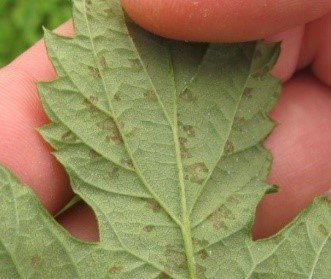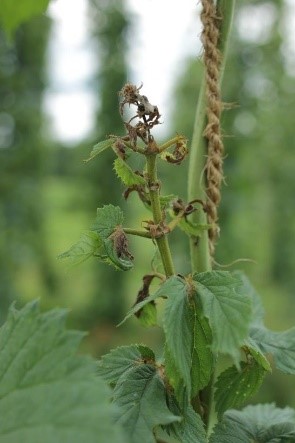Scouting for downy mildew in the hop yard. Now that the growing season is underway, it is important to be on the lookout for downy mildew! This spring has been very rainy, and the excess moisture on the hop plants creates ideal conditions for downy mildew infections. Downy mildew produces spores in warm, moist conditions and can spread quickly. Plants are at a higher risk during rainy days because the plant’s stomata, or pores, are open, leaving an open pathway for disease invasion.
Downy mildew is a systemic infection which means that once a plant has downy mildew, it is infected for life. At the end of the growing season, downy mildew will over winter in the crown of the infected hop plant, and re-emerge in the spring.

When scouting your hop yard, the first signs of a downy mildew infection are the basal spikes. Basal spikes are chlorotic, or yellowing, and have shortened internodes, or the space between leaf pairs. A severely infected basal spike may also have desiccated leaves.
Other signs of a downy mildew infection are aerial spikes and infected leaves, which will begin to appear as the season progresses. Aerial spikes have the same chlorotic appearance and short internodes as basal spikes, except they’re found on a trained plant rather than on the ground. Infected leaves have necrotic lesions, delineated by leaf veins. These lesions are angular and have very distinct edges, which can help with disease identification.

Downy mildew can be managed and there are methods to prevent the spread of infection. When scouting plants, it is important to trim off the infected bines and leaves, and to make sure that infected plant material is removed from the hop yard. If infected leaves have spores, be careful while handling them to reduce the risk of spreading infection.
Increased airflow is another way to reduce downy mildew. It reduces the amount of time your foliage spends wet, which decreases the time that downy mildew is producing spores. Stripping the lower 2 to 4 feet of foliage once a plant is trained and established can reduce moisture.
Biofungicides are another helpful tool to use during the season to control downy mildew, and they can be applied the day before a rain event. There are a variety of conventional and organic fungicides registered for hop use. If you live in Vermont, a list of OMRI-approved biofungicides can be found in the 2016 Hop Biofungicide Trial Research Report. It is very important to only apply fungicides that are listed in your state for use on hops so be sure to check the label.